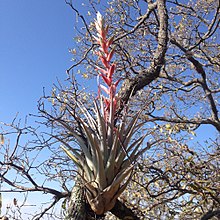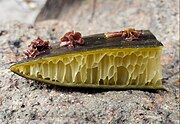Epiphyte

An epiphyte is a plant or plant-like organism that grows on the surface of another plant and derives its moisture and nutrients from the air, rain, water (in marine environments) or from debris accumulating around it. The plants on which epiphytes grow are called
Epiphyte is one of the subdivisions of the Raunkiær system. The term epiphytic derives from the Greek epi- (meaning 'upon') and phyton (meaning 'plant'). Epiphytic plants are sometimes called "air plants" because they do not root in soil. However, that term is inaccurate, as there are many aquatic species of
Terrestrial epiphytes
The best-known epiphytic plants include
The first important monograph on epiphytic plant ecology was written by A. F. W. Schimper (Die epiphytische Vegetation Amerikas, 1888). Assemblages of large epiphytes occur most abundantly in moist tropical forests, but mosses and lichens occur as epiphytes in almost all biomes. In Europe there are no dedicated epiphytic plants using roots, but rich assemblages of mosses and lichens grow on trees in damp areas (mainly the western coastal fringe), and the common polypody fern grows epiphytically along branches. Rarely, grass, small bushes or small trees may grow in suspended soils up trees (typically in a rot-hole).
-
Epiphytes can grow on the trunks of trees or sometimes in the canopy of a tree
-
An epiphytic orchid on a tree in a Brazilian cloud forest
-
Clinging root of an orchid
Holo-epiphyte or hemi-epiphyte
Epiphytes however, can generally be categorized into holo-epiphytes or hemi-epiphytes. A holo-epiphyte is a plant that spends its whole life cycle without contact with the ground and a hemi-epiphyte is a plant that spends only half of its life without the ground before the roots can reach or make contact with the ground.
Plant nutrient relations
Epiphytes are not connected to the soil, and consequently must get nutrients from other sources, such as fog, dew, rain and mist,
Epiphytes can have a significant effect on the microenvironment of their host, and of ecosystems where they are abundant, as they hold water in the canopy and decrease water input to the soil.[9] Some non-vascular epiphytes such as lichens and mosses are well known for their ability to take up water rapidly.[10] Epiphytes create a significantly cooler and more moist environment in the host plant canopy, potentially greatly reducing water loss by the host through transpiration.
Plant metabolism
CAM metabolism, a water-preserving metabolism present among various plant taxa, is particularly relevant to epiphytic communities.[11] For example, it is estimated that among epiphytic orchids, as many as 50% are likely to use it.[12] Other relevant epiphytic families which display such metabolism are Bromeliacee (e.g. in genera Aechmea and Tillandsia), Cactaceae (e.g. inRhipsalis and Epiphyllum) and Apocynaceae (e.g. in Hoya and Dischidia).
Marine epiphytes
The ecology of epiphytes in marine environments differs from those in terrestrial ecosystems. Epiphytes in marine systems are species of algae, bacteria, fungi, sponges, bryozoans, ascidians, protozoa, crustaceans, molluscs and any other sessile organism that grows on the surface of a plant, typically
-
Heavy epiphyte growth on kelp stipe
-
Hormosira banksii
-
Epiphytic Calothrix cyanobacteria (arrows) in symbiosis with a Chaetocerosdiatom (scale bar 50 μm)
-
Cross-section of a Durvillaea antarctica frond, showing Pyrophyllon subtumens growing on the outer surface
See also
- Tillandsia – a genus of the Bromeliaceae
- Epiphyllum – a genus of epiphytic cacti
- Parasitic plant
- Epilith, an organism that grows in a rock
- Foliicolous, lichens or bryophytes that grow on leaves of vascular plants
- Epiphytic bacteria
- Epiphytic fungus
- Canopy soils
References
- ^ Hickey, M.; King, C. (2001). The Cambridge Illustrated Glossary of Botanical Terms. Cambridge University Press.
- ^ Webster's Third New International Dictionary of the English Language, Unabridged. (1976). Vol. I, p. 764. Encyclopædia Britannica, Inc. Chicago.
- ^ Dabbs, Amy (19 December 2014). "Epiphytes are easy to grow Houseplants get water from air". Post and Courier. Retrieved 15 December 2016.
- doi:10.1139/b09-027. Archived from the original(PDF) on 2013-09-26.
- ^ Hogan, C Michael, 2010. Fern. Encyclopedia of Earth. National council for Science and the Environment Archived November 9, 2011, at the Wayback Machine. Washington, DC
- ^ Schuettpelz, Eric (2007), The evolution and diversification of epiphytic ferns (PDF), Duke University PhD thesis, archived from the original (PDF) on 2010-06-20, retrieved 2009-12-11
- S2CID 37082364.[permanent dead link]
- ^ S2CID 22635086.
- .
- ^ Johansson, Dick (1974). "ECOLOGY OF VASCULAR EPIPHYTES IN WEST AFRICAN RAIN FOREST" (PDF). Acta Phytogeographica Suecica. 59.
- PMC 10799991.
- ISSN 0070-8356.
- ^ a b "MV Commission" (PDF).
- ^ a b c d "www.SeagrassLI.org Cornell Cooperative Extension Eelgrass Restoration". www.seagrassli.org. Retrieved 2017-06-26.
- ^ a b "Marine Plants / Algae - Biscayne National Park (U.S. National Park Service)". www.nps.gov. Retrieved 2017-06-26.
- ^ "An Assessment of Coastal Hypoxia and Eutrophication in U.S. Waters" (PDF). NOAA. Archived from the original (PDF) on 2017-05-07. Retrieved 2017-06-26.







